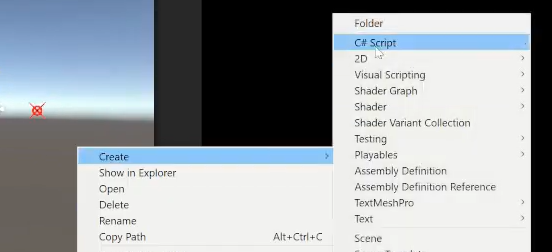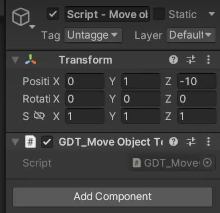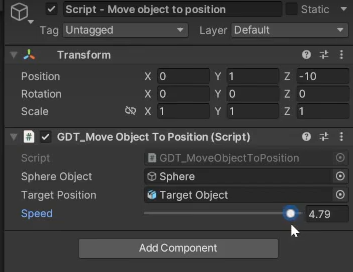In many games, you might need an enemy, follower, or NPC to chase the player or a target object. Unity provides several ways to achieve this, and in this article, we’ll focus on one simple yet effective method: the Vector3.MoveTowards() function.
This approach allows you to smoothly move one GameObject toward another at a controlled speed, making it ideal for basic AI movement, following mechanics, or even simple pathfinding. We’ll break down how it works, how to implement it in a script, and how to customize its behavior.
For a visual breakdown of this subject, you may find my video discussion helpful.
To begin, create a new C# script in Unity by right-clicking in the Project Window and selecting Create > C# Script (See Figure 1). Name it (e.g., ChaseTarget), then double-click to edit it in your code editor.


Next, drag the script from the Project Window onto an empty GameObject in your scene’s Hierarchy. This assigns the script as a component, allowing you to define movement logic (like MoveTowards) that will execute during gameplay.
How to Move an Object to a Target Position in Unity (Using C# Scripting)
In your script, define two public GameObject variables to reference the moving object and its target (See Figure 3) and a float variable for the speed of the chasing object:
public GameObject sphereObject; // The object that will move (e.g., a sphere)
public GameObject targetPosition; // The target to chase
public float speed = 1f; //The speed of the chasing object

After saving the script, return to Unity’s Editor (See Figure 4 for visual reference):
- Select the GameObject with your script attached.
- In the Inspector, you’ll see the two empty fields for
sphereObjectandtargetPosition. - Drag and drop the respective GameObjects from your scene or Hierarchy into these slots.
Now your script can access these objects at runtime! (Tip: Mark variables as [SerializeField] if you prefer private fields to appear in the Inspector.)

Movement instructions and safety checks
To move the sphereObject toward the targetPosition, use Vector3.MoveTowards() inside an update method (e.g., Update(), FixedUpdate(), or LateUpdate()). Add the speed variable to control movement and multiply it by Time.deltaTime for frame-rate independence:
void Update()
{
if (targetPosition != null)
{
sphereObject.transform.position = Vector3.MoveTowards(
sphereObject.transform.position,
targetPosition.transform.position,
speed * Time.deltaTime
);
}
}
About the Update functions
- Update Methods:
Update(): Standard for most movement (runs every frame).FixedUpdate(): Preferred for physics-based movement (syncs with physics steps).LateUpdate(): Useful if movement should follow other calculations (e.g., camera tracking).
- Safety Check: Always validate
targetPositionexists to avoidNullReferenceException.

